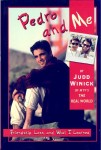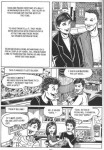This is a very special book. This is not a work of fiction, but the account by Judd Winick of his friendship with Pedro Zamora. They met during a season of The Real World, a show I know only by hearsay, not getting American tv. We have enough “reality tv” here in France. Anyway.
Zamora had been an AIDS educator for a few years, and saw the show as a good opportunity for him to spread knowledge about the disease. He also had been HIV-positive since he was seventeen. He only lived with the disease for five years before his death in 1994.
Winick was a struggling cartoonist, and Pedro and Me1 would become his first extended work after lots of efforts trying to make it in the comic strip format. For a time, he became an AIDS educator, but had to stop doing that because of his personal and professional life. Besides his more personal work for Oni Press, he currently writes two mainstream titles (Green Lantern for DC Comics and Exiles for Marvel), in which he includes gay characters.
This book is all the more impressive as Winick has managed to avoid all the tear-jerking aspects such a story could contain: a young guy, who’s obviously a great human being, dies at 22 from AIDS. Yes, that could sum up the book. But that would mean a lot more is left out. The laughs and good times had by all. The warmth of the people involved. The growing love between Judd and Pam, another Real World participant, as well as between Pedro and Sean (see the image on the left). The deep sympathy between Zamora and Winick. It is so rare to see a story, fictional or otherwise, which depicts such a friendship, as if gay guys could only befriend straight women. This cliché might be funny for a time, but real life is far more diversified. And Winick shows all the moments, sad or not, in a low-key way which does not tell the reader how to feel or what to think.
His art is at the same time realistic (people are recognizable from the photos) and very cartoony (especially the face expressions).The storytelling is fluid, with a sparse use of full-page panels.
Each time I pick up this book to read a few pages, I have a knot in my stomach. The people depicted by Winick are so human, so full of life, that it’s hard to think that one of them died at the age a lot of people begin to get a life. But at the same time, reading a few pages reminds me why I find this book important: without shirking the pain Pedro’s death brought on all his friends and family, Winick celebrates the life of his friend and the ways he’s changed him for the better. Pedro Zamora didn’t deserve to die at 22. Nobody does. But with this book, his life-affirming message keeps on being told to more and more people.
Notes:


 Bluesky feed
Bluesky feed